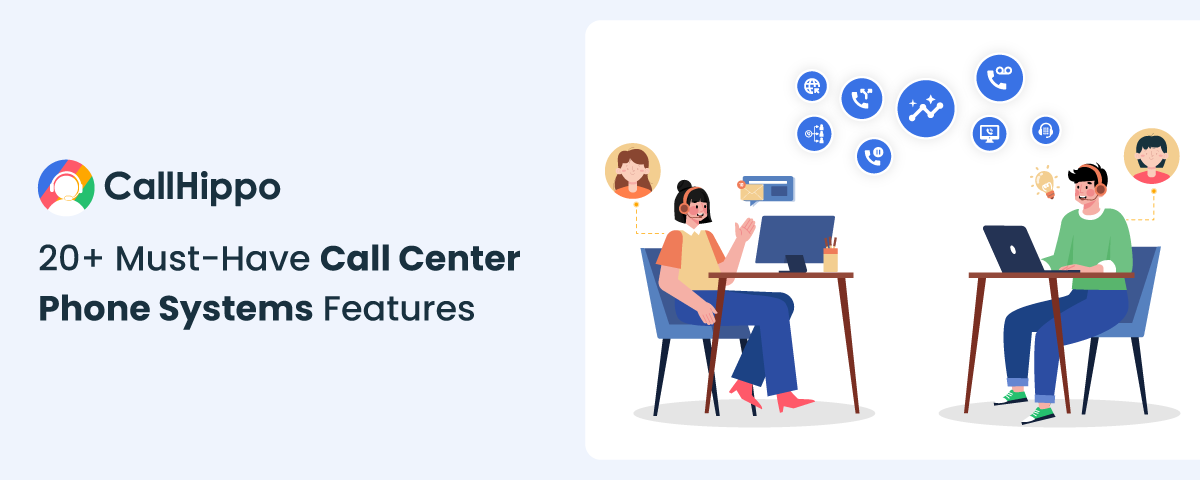Customers communicate with modern businesses through a variety of channels, including phone, email, and chatbots that offer advanced call center features. Leveraging these technologies is critical for efficiency.
We’ve listed the most vital call center phone system features to consider for your next platform. Let’s take a look.
When selecting a call center system, prioritize features like IVR for efficient call routing, call recording for training and compliance, and analytics for performance insights. These tools enhance customer service and streamline operations.
Top Call Center Phone System Features
Here are some key call center features that can improve customer service and productivity for many organizations. Before choosing call center software, you need first to determine your needs.
1. Interactive Voice Response (IVR) System
An Interactive Voice Response (IVR) system is an automated voice menu that directs callers to the right agent based on their requirements. To improve the customer experience, IVR systems should be simple and intuitive.
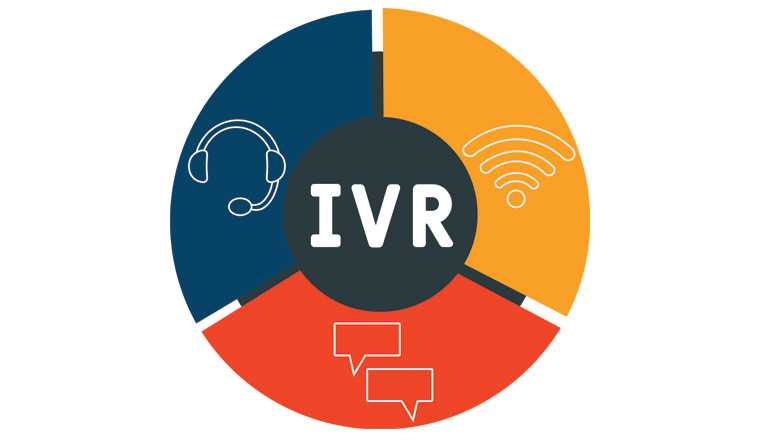
( Source: callcentrehelper )
Customers can specify their purpose for calling using customizable call menus, ensuring they are linked to a qualified agent who can answer their questions. It minimizes the need for repeated explanations, and calls are transferred less frequently.
Advanced IVR systems feature speech recognition, allowing for smoother connections to the appropriate department. These systems range from simple call routing to complex solutions that let clients access their accounts and perform self-service chores, reducing the workload on human operators.
Customers can navigate the IVR menu by touching buttons on their phones. It results in satisfied customers, accessible support representatives, and higher employee productivity.
2. Call Queue
A call queue is a system feature that lets many callers wait their turn to talk with an agent rather than being disconnected. This functionality is enabled when all call agents are busy. When multiple callers phone a number at the same time, they are placed in a virtual queue until an agent is available. During their wait, callers often listen to on-hold music or recorded messages, and they may be notified of their queue position or expected wait time.
To properly handle high call volumes, contact centers and customer service departments must use call queues. They contribute to agents’ ability to respond to calls quickly, reduce wait times, and increase customer satisfaction. Call queues work by arranging incoming calls into a line according to established rules.
3. Call Recording
Call recording, often known as phone recording or voice logging, is the ability to record a voice discussion from an audio source. Active or conference calls can be recorded and saved as digital files for later transcription or playback. Call recording feature is essential for training and supervision since it allows managers and operators to capture and save phone conversations as audio files on a server.
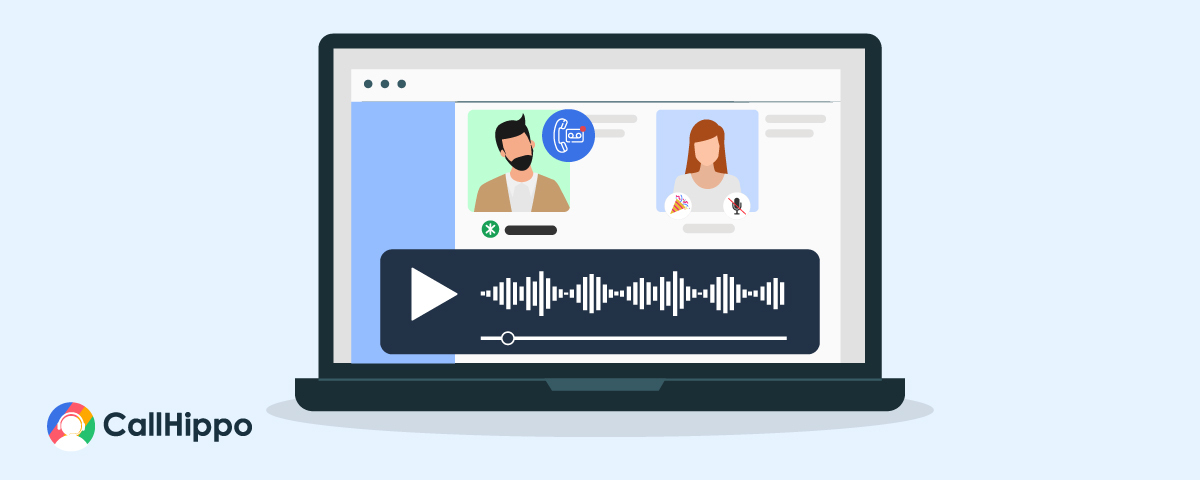
Third-party and cloud-hosted systems are better suited for this purpose since they provide smooth storage upgrades without the need for extra hardware. Call recording allows users to record both incoming (for inbound call centers) and outbound calls (for outbound call centers), with the option to preserve and retrieve the recordings later.
4. Call Monitoring
Call monitoring falls into two categories:
- Real-time monitoring enables instant coaching and action.
- After-the-fact monitoring examines call recordings to pinpoint areas for improvement.
Combining these strategies allows a comprehensive quality assurance program that is both reactive and proactive. This technique allows you to handle issues as they arise and to build a structured evaluation process for specific calls and agents. This feature benefits team members of all levels.
Call recordings can help new hires understand their jobs and obtain real-world experience. Managers and supervisors use these call center solution recordings to track department development, monitor KPIs, and create plans to improve the client experience.
5. Automatic Call Distribution (ACD)
Automatic call distribution (ACD) intelligently routes calls to the appropriate agent or department each time. It allows calls to be routed depending on caller ID, business hours, customer care tier, and IVR selections.
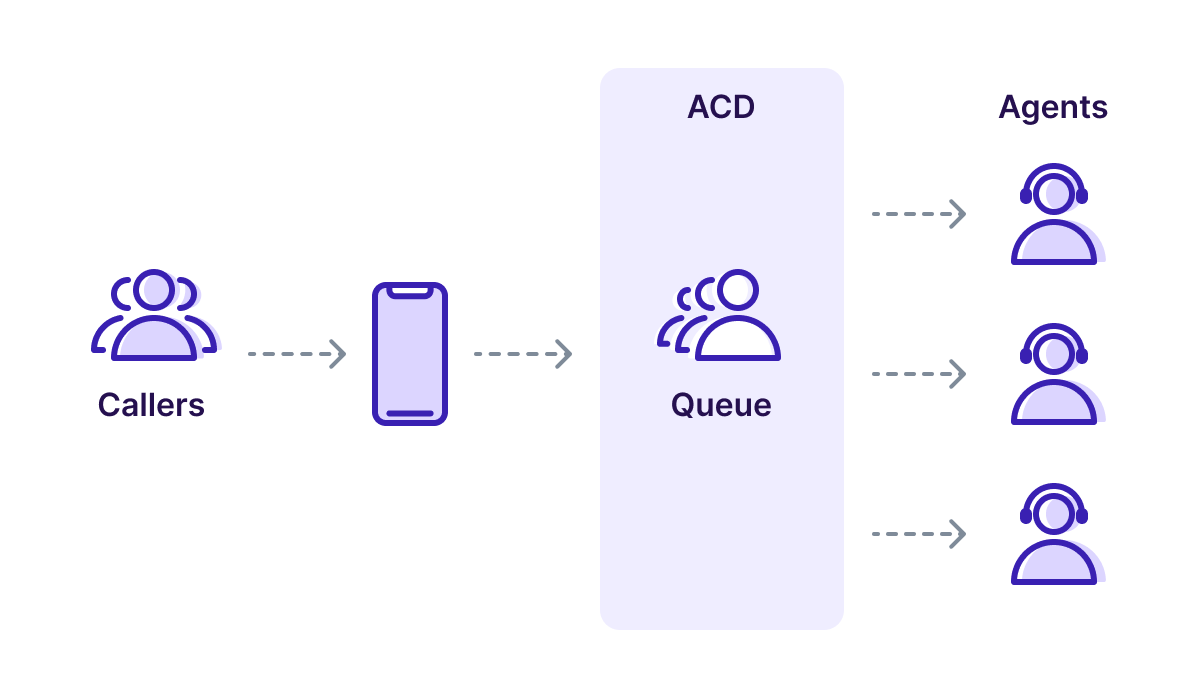
This guarantees that inbound calls are quickly routed to the relevant agent or department without the caller having to dial multiple numbers. If your goal is to distribute call loads evenly among agents, ACD can send the next call to the agent with the fewest calls for the day.
ACD systems route calls depending on user-defined parameters, such as routing calls to idle phones or billing questions to certain departments like accounting. These systems range from basic pushbutton virtual operators to complex configurations that use caller ID or speech recognition. ACD systems can use IVR, caller ID, or voice recognition, all of which help to save time and improve customer satisfaction.
6. Call Routing
Call routing is a significant call management feature in business phone systems that queues incoming calls and directs them to certain individuals or groups based on predefined rules and criteria. This process occurs before the recipient answers the phone calls.
Call routing is frequently regarded as the most significant element of a contact center phone system. It enables businesses to efficiently manage the flow of incoming calls based on a variety of parameters, including:
- Time-based routing handles calls differently depending on whether they arrive during or after business hours.
- Skill-based routing directs calls to the best appropriate agent depending on the caller’s needs, which are frequently determined using an IVR system.
- Fixed order routing ensures that calls are routed in a certain, preset sequence.
- Percentage-based routing distributes calls so that each agent receives a roughly equal share of the total call volume.
7. Call Transfer
Almost all contact centers require the ability to transfer calls from one department to another or provide access to a third party. Although most systems offer these features, it is necessary to double-check their presence. Call transfer has been an integral part of modern phone systems since their creation, and its significance has only grown as businesses have grown in size and global reach.
VoIP services provide two sorts of call transfers: cold and warm. A cold transfer is passing a call to someone without prior notification. In contrast, a warm transfer enables the current agent to brief the next person before transferring the call.
8. Voicemail Transcription
Voicemail transcription is a telecommunication feature that transforms spoken voicemail messages into text. This method converts voicemail material to text, allowing for faster message delivery via email or text. Such systems can quickly route critical information to the relevant individuals for inbound and outbound calls, improving customer service efficiency even while agents are busy with other responsibilities.
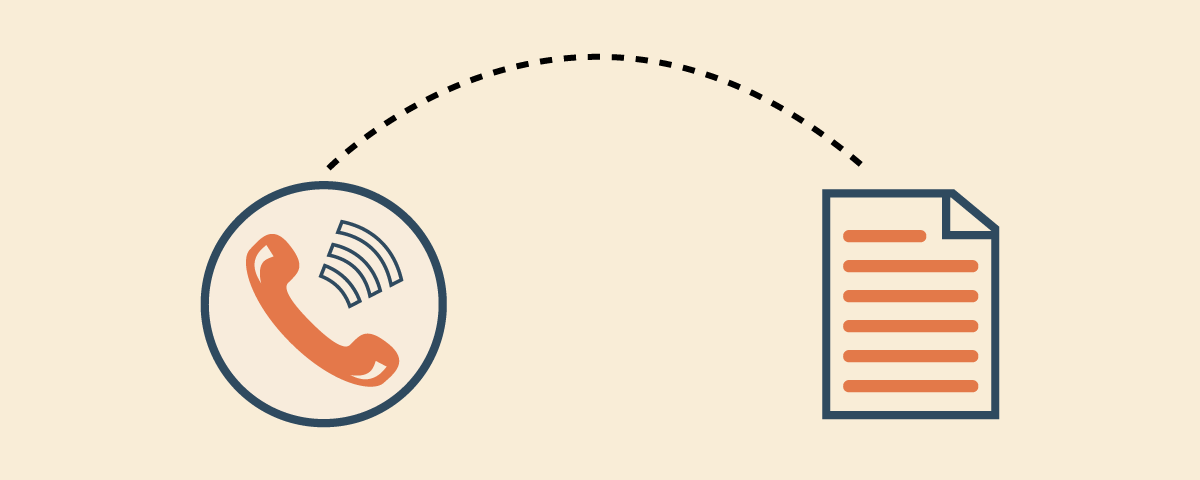
This streamlined communication technique promotes faster conflict resolution and consistent technical support, ultimately improving overall customer service quality for your company.
9. Auto Attendant
An auto attendant functions as a virtual receptionist, minimizing the need for additional employee expenses. Its major goal is to route calls to the proper department or people while also providing configurable greetings and menu options to improve the caller experience.
Customers value the tailored menus, and businesses gain from efficiently managing large call volumes. Customers choose auto attendants over several transfers and long hold times because they provide quick, efficient, and customized service.
Auto attendants are critical for quickly managing incoming calls without the need for a specialized receptionist. They streamline operations, lower expenses, and ensure that callers receive quick and friendly support without delay.
10. Call Analytics
Call analytics is a call center feature that collects detailed information from inbound calls, including caller information and the originating marketing source. It includes measuring, collecting, analyzing, and reporting on call data, allowing teams in marketing, customer support, and sales to optimize their plans and call-handling methods.
Implementing call analytics is critical for accurately evaluating and managing the performance of customer service or sales professionals. It also helps to maximize ROI through strategic insights gained from call analysis.
These actionable analytics enable businesses to detect conversion challenges, make smart budgeting decisions, and adjust ad targeting based on caller preferences. This results in increased lead volume at a lower Cost Per Lead (CPL).
11. Smart Switch
Smart Switch is a modern invention in virtual phone systems that turns regular call routing into an extremely efficient operation. Smart Switch uses powerful algorithms and AI-driven reasoning to automatically divert incoming calls based on predefined parameters. It guarantees that each call is swiftly directed to the appropriate team member or department, avoiding the delays and inefficiencies associated with traditional call-forwarding solutions.
Businesses should abandon time-consuming processes in favor of a more efficient approach to call management that improves precision and responsiveness. Smart Switch offers extensive analytics and insights into call performance and routing trends.
They can use these analytical capabilities to acquire useful insights about call-handling techniques, allowing for better decision-making and continuous development. Organizations can use Smart Switch’s reporting features to spot patterns, streamline workflows, and improve overall operational efficiency.
12. Call Barging
Phone conversations can, at times, stall, whether owing to challenging customers, unusual conditions, or other issues beyond the agent’s control.
Call barging develops as a critical tool, allowing management to intervene in real-time conversations between agents and clients. This tool maintains call quality but also allows supervisors to properly coach agents in the contact center environment.
Call barging turns the supervisor-agent-customer relationship into a collaborative three-way interaction. This capacity is helpful when agents encounter inquiries beyond their area of expertise, allowing supervisors to effortlessly join and assist, hence increasing customer satisfaction and service efficiency.
13. Call Hold Audio
The act of waiting for incoming calls can be bothersome, and it is known to cause caller disengagement. Thus, the incorporation of hold audio is an archaic yet vital feature in call center systems. These technologies allow agents to entertain callers with music while they wait.
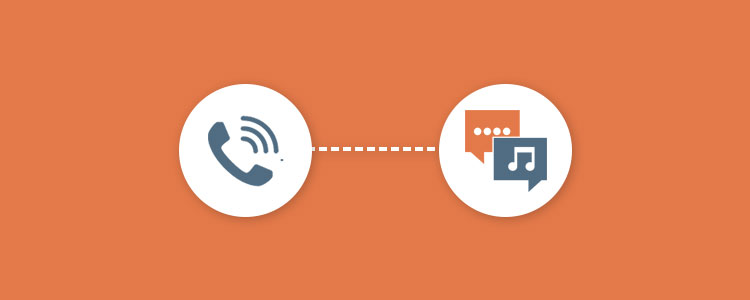
Though seemingly insignificant, holding music significantly reduces the discomfort of quiet, lowering the chance of premature call abandonment and subsequent complaints. This method, known as music on hold, carefully uses auditory cues to reduce perceived wait times and increase brand engagement, which is especially important for businesses dealing with high call volumes.
Furthermore, businesses can customize this auditory experience to include advertising messaging, thereby keeping callers engaged until they connect with a live representative.
14. Multi-line Phone System
A multi-line phone system improves workplace efficiency by allowing many calls to be handled at the same time, making it easier to place calls on hold, dial internal or external numbers, and return to present conversations.
Multi-line systems efficiently manage multiple incoming calls. They enable teams to multitask, such as putting one call on wait while initiating another, whether internal or external and seamlessly returning to the original call.
Businesses can establish multi-line telephone networks using two main methods:
- On-premises multi-line phone systems that rely on traditional telecom infrastructure such as Private Branch Exchanges (PBX) or Key System Units (KSU) and require technical skills for management.
- Cloud-based multi-line phone systems are a modern solution hosted in the cloud that provides scalability and accessibility without the need for actual on-site equipment. They use technologies such as VoIP services or IP PBXs.
15. Post-Call Surveys
Rather than presuming your customer had a positive call, users can improve their strategy by implementing immediate feedback options. They can use customer experience software to automate the transmission of surveys that analyze both agent performance and caller satisfaction. It is helpful in refining training programs and improving overall service quality through continuous improvement activities.
Post-call surveys are a common way for contact centers to acquire customer insights. Following each engagement, consumers are asked to score their experience on a number scale, providing vital feedback on agent effectiveness and service quality throughout the business.
16. Predictive Dialer
A predictive dialer is an optimized approach that decreases downtime and the number of unsuccessful phone attempts. Ideal for call center dialers, it excels in proactive customer service, lead creation, and high-volume follow-ups.
A predictive dialer uses advanced algorithms to decide the best phone number to call and which person should handle the call, utilizing computational capacity to improve both speed and efficacy. The technique is designed to maximize call centers’ operational efficiency, resulting in increased production and better outcomes.
17. Power Dialer
A power dialer is an automatic telephone equipment that dials the next phone number on a list as soon as the previous call ends. This software is especially handy for cold calling and telemarketing because it allows operators to conduct multiple calls quickly without manually dialing each number.
The power dialer automates the dialing process, allowing future calls to begin immediately when the current call ends. This technology is critical for call centers looking to maximize outreach efficiency since it allows agents to quickly interact with a huge number of contacts.
As a result, the power dialer has become an essential component of modern call center systems, speeding the process of placing high-volume calls.
18. Speech Analytics
Speech analytics uses advanced technology to listen to and analyze conversations, with AI handling massive amounts of unstructured data with ease. This method enables the detection of words and the analysis of audio patterns to detect emotions, monitor agent performance, and measure call quality.
Speech analytics is powered by advanced methods like machine learning and natural language processing (NLP). It uses advanced algorithms to thoroughly investigate historical audio data from customer contacts. These algorithms work like detectives, meticulously finding patterns, trends, and insights that disclose critical information about client wants, preferences, and pain spots.
19. Sticky Agent
A sticky agent feature allows your clients to contact the same customer support representative on several occasions, assuring consistency and personalized service. This lets the agent immediately learn the customer’s requirements and preferences based on their interaction history.
Using this capacity, agents can provide more personalized service, which increases customer satisfaction. Sticky agents are categorized into two types:
- Basic Sticky Agent: This type only connects calls to certain agents who have already engaged with the consumer. If the agent is unavailable, the call will be disconnected.
- Advanced Sticky Agent: This type transfers the call to another agent if the original person is unavailable, ensuring that the consumer receives prompt assistance.
20. Smart DID Routing
Smart DID routing is an advanced telecommunications technology that effectively directs incoming calls depending on a variety of parameters, including the caller’s demands and agent availability. This technology improves call management and the customer experience by using data and algorithms to match callers with the most appropriate operators.
Smart DID routing greatly improves first-contact resolution by replacing the traditional one-size-fits-all approach. It gathers information about callers and their needs, then employs complex algorithms to match them with the appropriate agent on the first attempt. It minimizes unnecessary transfers, connects consumers promptly to a qualified agent, and speeds up issue resolution, resulting in more satisfied customers and fewer repeat calls.
21. Sentiment Analysis
Sentiment analysis uses natural language processing and machine learning to identify customer tone, intent, and sentiment across various touchpoints and channels, including voice, chat, online reviews, and feedback.
In addition to providing an overall sentiment score for your contact center, sentiment analysis improves other workforce optimization (WFO) measures by linking sentiment to call duration, hold time, quiet, evaluation scores, and Net Promoter Score (NPS). Sentiment analysis in call centers provides a full insight into customer perceptions of your products, services, and brand. This deeper understanding is crucial for making better decisions and strategic goals.
22. Self Service Portals
Self-service allows customers to fix issues on their own without waiting for a response from a support person, reducing the workload on your customer care team. When clients can readily obtain the information they require, routine inquiries are answered without the need for agent intervention, reducing call volume. As a result, only the most complex or unique situations are escalated to live agents.
A self-service portal can offer customers information on:
- Billing and invoices
- Service Status Updates
- Progress in support cases
- Progress of orders
- Delivery status
Top 3 Call Center Phone Systems
There is a vast range of high-quality company call center system providers available. We’ve selected the top three for you.
1. CallHippo
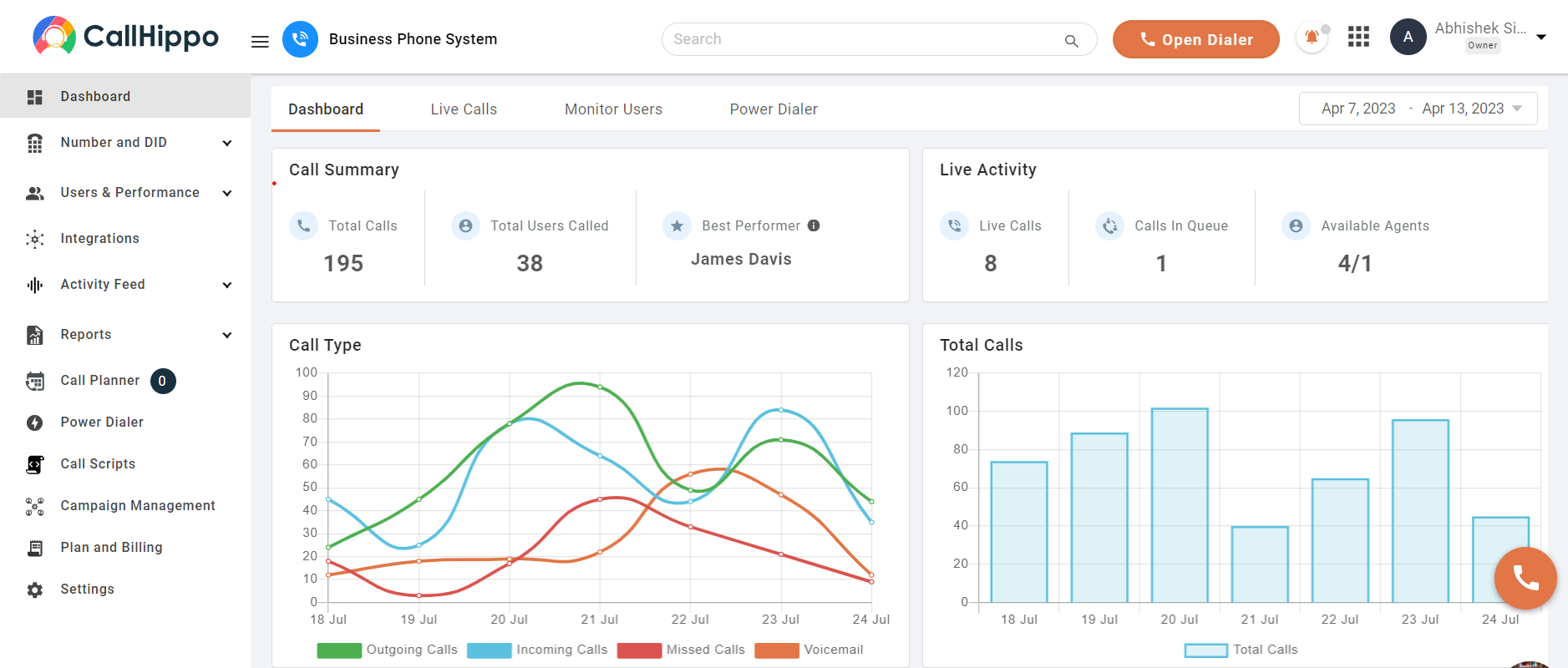
CallHippo is a versatile cloud-based VoIP solution that caters to companies of all sizes. It is known for its user-friendly interface and includes a number of advanced functions, such as call tracking, recording, and intelligent routing. CallHippo integrates seamlessly with a variety of CRM and helpdesk solutions, ensuring that operations run smoothly.
It also offers virtual phone numbers from 50+ countries, enabling businesses to develop a global presence. Additional capabilities, like on-hold music, voicemail transcription, and analytics dashboards, assist businesses in optimizing their communication processes.
Features
- Call tracking
- AI voicebox
- IVR
- CallHippo AI
- Predictive analytics
Pros
- Quick, knowledgeable help through multiple support channels.
- Reliable, flexible call redirection without connection issues.
- Smooth data flow and customizable integrations with various applications.
Cons
- Frequent bugs and performance issues across different devices.
- Complex, multi-step payment process with limited options.
Pricing
- Starter: $18 Per user/Month
- Professional: $ 30 Per user/Month
- Ultimate: $ 42 Per user/Month
*Pricing as per 06-02-2025.
2. Dialpad
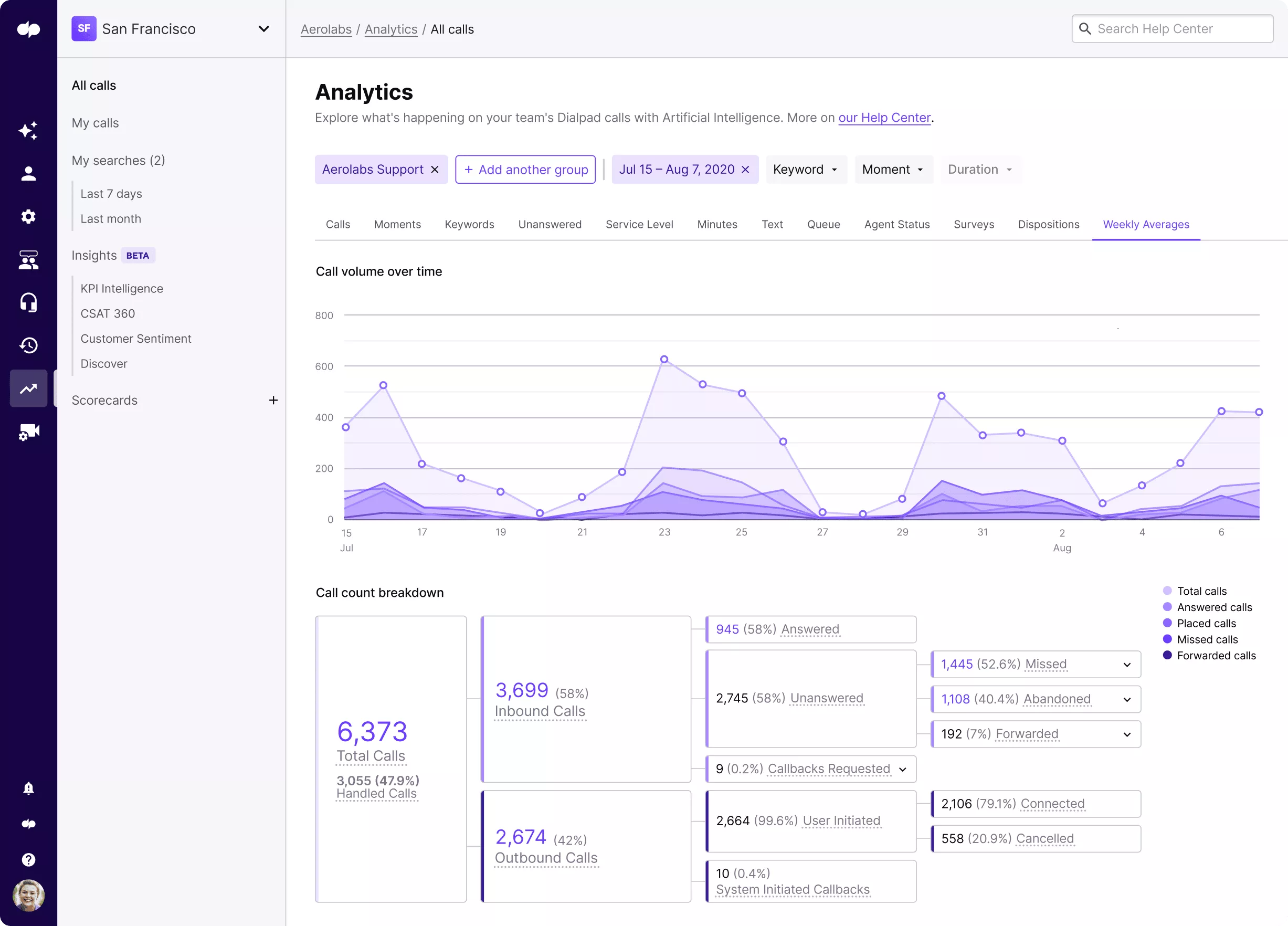
Dialpad is a comprehensive workplace communication platform with AI-powered capabilities that aim to increase productivity. It provides a unified solution for audio, video, text, and meetings, allowing for seamless communication across several devices.
Its strong analytics and reporting capabilities allow firms to track performance and make data-driven choices. Dialpad’s user-friendly design, paired with its robust capabilities, make it a fantastic choice for enterprises looking to streamline their communication systems.
Features
- Call monitoring
- Call queues
- Call recording
- Call reporting
- Call scheduling
Pros
- Clear and reliable audio enhances communication and productivity.
- Affordable, user-friendly, and multi-platform apps for small businesses.
- Gathers essential information from diverse sources for detailed analysis.
Cons
- New users need time to grasp and use complex features.
- Notifications may be untimely or lack necessary details for users.
Pricing
- Standard: $15 user/month
- Pro: $25 user/month
- Enterprise: custom pricing
- 14-day-free-trial
*Pricing as per 06-02-2025.
3. Nextiva
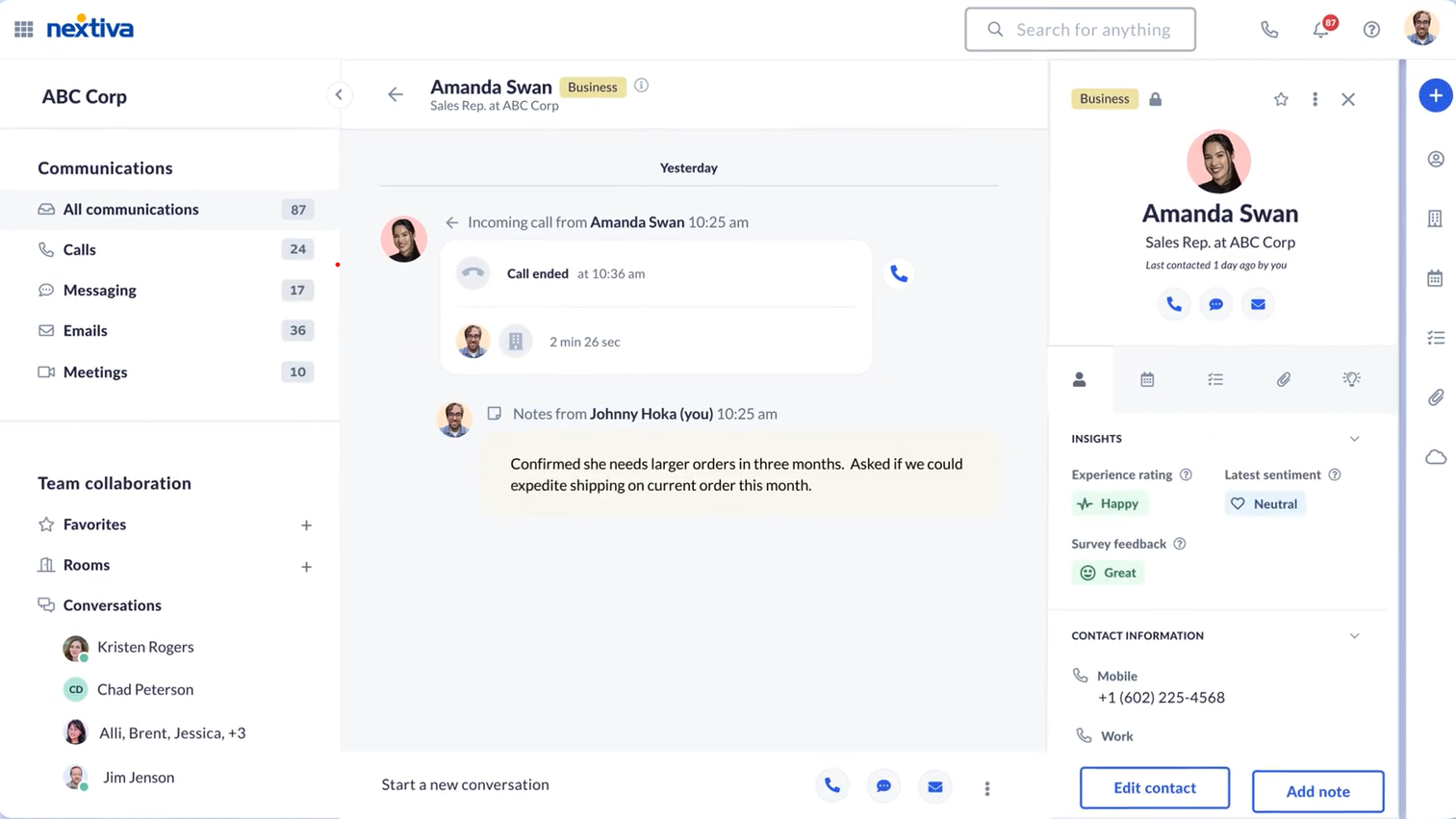
Nextiva is a major provider of VoIP and unified communication solutions, noted for its reliability and extensive feature set. It offers advanced services for organizations, like call forwarding, auto-attendant, voicemail-to-email, and call analytics. Nextiva’s platform interfaces with a variety of CRM and productivity applications, allowing for more efficient operations and improved client engagement.
Nextiva’s scalable solutions appeal to enterprises of all sizes, making it a top choice for those looking for complete and reliable communication services.
Features
- Call scheduling
- Call screening
- Call tracking metrics
- Complaint monitoring
- Contact management
Pros
- Affordable and accessible for non-tech-savvy individuals, intuitive design.
- Superior customer support, reliable performance, and prompt issue resolution.
- Extensive customization options, flexible management, and centralized control.
Cons
- Audio clarity issues, occasional drops, and inconsistent connection.
- Login problems, authentication failures, interrupted access, and inconvenient experiences.
Pricing
The customer conversation suite pricing includes the following:
- Essential: $18.95 user/month
- Professional: $22.95 user/month
- Enterprise: $32.95 user/month
- 7-day-free-trial
*Pricing as per 06-02-2025.
Conclusion
Ensure the business phone service features you choose supports your company’s growth. If your call center software has the features above, you are well prepared for the challenges of the future. Modern call centers have progressed beyond basic services like call routing and recording to include complex capabilities like analytics, chat, and CRM connection.
These improvements significantly improve call center operations. The discussion focuses on the many aspects of a modern call center, as well as their significance in simplifying processes and increasing efficiency.
Frequently Asked Questions
1. How much does a call center phone system cost?
The initial cost ranges from $1,850 to $12,750, with possible increases if gear is purchased for several agents. Monthly expenses range from $1,200 to $7,600 and may increase with larger teams due to software fees charged per user.
2. What devices are used in call centers?
Call centers use computers, headsets, VoIP phones, and CRM systems. These tools allow agents to handle calls more efficiently, retrieve consumer information, and maintain the communication standards required for excellent customer care.
3. How does a call center phone system work?
A call center phone system handles incoming and outgoing calls and routes them to agents using established rules or interactive voice response (IVR) menus. It includes features like call queuing, forwarding, and monitoring to improve customer service efficiency.

Subscribe to our newsletter & never miss our latest news and promotions.
